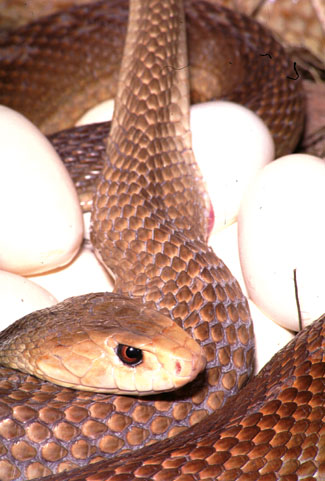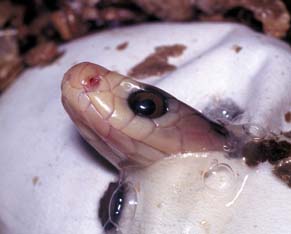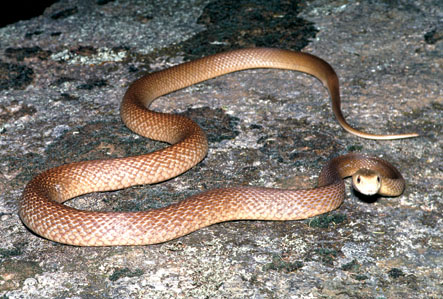|
AN OVERVIEW OF THE TAIPANS, GENUS (OXYURANUS) (SERPENTES:ELAPIDAE) |
Raymond Hoser
488 Park Road Park Orchards, Victoria, 3114, Australia.
Phone: +61 3 9812 3322 Fax: +61 3 9812 3355 E-mail: XXXX
Originally Published in Crocodilian - Journal of the Victorian Association of Amateur Herpetologists 3(1), pages 43-50 - May 2002
(Reprinted in 2003 in the Alberta Reptile and Amphibian Society Bulletin 16(8):31-33, 39.)
Taipans are among the most well-known of Australia’s snakes. Laboratory studies show that they have the most toxic venom of all land snakes in terms of the number of mice killed per milking of venom. It is generally accepted that there are two species, namely the ‘Coastal’ (or ‘Mainland’) (Oxyuranus scutellatus) and the ‘Inland’ (Oxyuranus microlepidota).
The venoms of all Taipans are neutralised by the same anti-venom. Tests have shown the New Guinea and Inland Taipans to kill an average of more mice per milking of venom than the Coastal Queensland form. However, these results may be skewed on the basis of larger or better yielding individuals being used for milking and may reflect individual differences between snakes as opposed to a generic difference between the different forms. The sample sizes used to derive the relative toxicity figures for the various types of Taipan have been small.
The general appearance of Inland and Coastal Taipans can be seen from the photos published in Hoser (1989), O’Shea (1996) and elsewhere. In terms of average adult length, these snakes are the longest Australasian elapids, with mature (non-growing) adults averaging over 2 metres and believed to have exceeded three metres. The King Brown Snake Cannia australis (Gray, 1842), (formerly known as Pseudechis australis) from the top-end of the Northern Territory also averages a similar length to the Taipans and is generally of much heavier build. Therefore that species may in fact lay claim to being Australasia’s largest and/or heaviest venomous snake.
All Taipans are characterised by the following suite of characters: smooth or lightly keeled scales (usually keeling is in the neck region), 21-23 mid body rows, no suboculars, single anal, divided subcaudals and 1-4 maxillary teeth following the fang (Cogger 1992).
CAPTIVITY
 All Taipans thrive in captivity and breed readily. Breeding and husbandry data for the genus is provided by a number of authors including, Banks (1983), Peters (1973), Shine and Covacevich (1983) and others. Breeding of both species of Taipan is now so common in herpetoculture, that it is generally regarded as an uneventful and routine event.
All Taipans thrive in captivity and breed readily. Breeding and husbandry data for the genus is provided by a number of authors including, Banks (1983), Peters (1973), Shine and Covacevich (1983) and others. Breeding of both species of Taipan is now so common in herpetoculture, that it is generally regarded as an uneventful and routine event.
Perhaps the most detailed account of husbandry and breeding of this genus is provided by Barnett (1999). Methods perfected by Brian Barnett to keep and breed Taipans have been emulated by others who have also bred both Inland and Coastal Taipans. The following information is essentially derived from Barnett’s 1999 paper. That paper details 20 separate Taipan breedings.
Most keepers successfully keep their Taipans in top-opening wooden boxes with glass lids. The layout of the cage is simple, both for ease of maintenance and also safety aspects when handling and removing snakes.
The substrate used is either small pebbles (in Barnett’s case) or newspaper (most other keepers). A hide box and water bowl is provided. Heating is provided either by a lamp or under the cage via thermofilm (heat mats) or similar. Keepers usually have a temperature gradient in the cage (essential to long term success) and usually use timers or similar to emulate a diurnal temperature fluctuation as occurs in the wild.
Breeding is initiated both by dropping the temperature during the "winter" season and separation of the sexes prior to a planned mating. The male is usually introduced to the female immediately after her sloughing (which occurs usually about every 46-67 days), Barnett (1999), although it is presumed that for many snakes mating may be initiated at other times (between sloughs). Barnett is of the view that the chances of initiating a successful mating are at their best immediately after the female sloughs.
 In Australia, Barnett reported the best time of year for successful matings was August/September (end of winter), but that is also dependent on the temperature cycle (annual cycle) employed by the keeper. Barnett (1999) reported mating’s lasting up to 6 hours.
In Australia, Barnett reported the best time of year for successful matings was August/September (end of winter), but that is also dependent on the temperature cycle (annual cycle) employed by the keeper. Barnett (1999) reported mating’s lasting up to 6 hours.
Taipans lay their eggs 11-14 days after a pre-laying slough. A similar routine is common for many Australian elapids. In captivity, the female snakes lay their eggs in a shallow depression as best that the snake can make. However where the snakes lay their eggs in the wild is another matter. To date no studies have been done on the egg-laying biology of wild Taipans.
Females when laying their eggs are remarkably calm in disposition and do not object to the keeper removing eggs as they are laid. An egg-laying female observed by this author had no objections to being moved (gently - and "freehandled") or photographed by this author.
The eggs themselves weigh an average of between 24.2 and 36.2 grams, although individual eggs within a given clutch may have weights outside this range.
Eggs are successfully hatched 2/3 buried in vermiculite (course not fine grade) at about 45-50% water to 55-50% vermiculite (by dry weight) in almost airtight containers in an incubator at constant temperature throughout. Barnett has successfully used an incubator powered by light-bulbs and regulated with a thermostat. The temperature is at an even 29.5-31 degrees Celsius. The eggs themselves are placed apart inside plastic containers sold in Australia as "click-clacks". Each click-clack can hold all or most of a clutch, (depending on the size of the click-clack). Using the above conditions Barnett has incubated over 20 clutches of Taipan eggs. The eggs took from 65 to 71 days to hatch. Some of Barnett’s females double clutched producing more than one fertile clutch of eggs. Taipans (both species) are also able to store sperm for some time. This is believed to assist the snakes if and when double-clutching in the wild.
Using the above conditions Barnett has incubated over 20 clutches of Taipan eggs. The eggs took from 65 to 71 days to hatch. Some of Barnett’s females double clutched producing more than one fertile clutch of eggs. Taipans (both species) are also able to store sperm for some time. This is believed to assist the snakes if and when double-clutching in the wild.
Newly hatched snakes measured an average of about 45 cm (total length), although the range in size documented was from 280 mm to 505 mm.
Young Taipans (all species) grow rapidly and it is common for young captives to exceed 2 metres at two years of age. Initially, they have a preference for taking moving objects.
INLAND TAIPAN Oxyuranus microlepidota (McCoy, 1879)
This dangerous snake attains two metres in length, although specimens of nearly three metres are known. The colour of this snake is brownish, but changes seasonally. In winter specimens are dark brown with blackish heads whilst in summer specimens are a light brownish colour without a blackish head. This snake is found on black soil plains of the 'channel country' of the Northern Territory, Queensland, South Australia and north west NSW. Old records from last century show this snake as occurring along the Murray-Darling river system but none have been found in this area since then.
Worrell (1972) reported anecdotal reports of these snakes from along the Darling River system in western NSW in years gone by, but none have been authentically reported from the area. There are old museum specimens labelled as coming from the junction of the Murray and Darling Rivers in Victoria (at the NSW border). Because other large brown snakes (Pseudonaja and Cannia (species formerly known as Pseudechis)) are known to occur in the area, it is uncertain as to whether the reports made to Worrell were of Taipans or other species.
For the Inland Taipan, the scalation is smooth with 23 mid body rows, 220-250 ventrals, anal is usually single, and 55-70 divided subcaudals.
This snake shares with the Coastal Taipan Oxyuranus scutellatus the distinction of being Australia’s deadliest snake, in terms of venom deadliness per bite. Published records suggest that an average bite can kill 50,000 mice; (estimated at about 50 human lethal doses in laboratory terms).
The Inland Taipan is diurnal and lives on black soil plains where it occurs. When inactive it hides in the large cracks that form in this soil. This snake which is often common where it occurs is mostly caught when foraging over the plains in the morning and at dusk, when it is not too hot. Most specimens are seen in spring and autumn.
When this snake bites its prey it hangs on, unlike the Mainland Taipan Oxyuranus scutellatus which lets go of it. In the wild it is believed that the Inland Taipan feeds principally on the plague rat Rattus villosissimus. In captivity, adults of this snake are not at all aggressive. They are far more placid in nature than most other deadly snakes.
About twelve eggs are produced in summer. Hatchlings measure about 42-27 cm.
This species has been placed in the monotypic genus Parademansia by a number of herpetologists. There is a strong argument for such a generic arrangement.
MAINLAND OR COASTAL TAIPAN Oxyuranus scutellatus (Peters, 1867)
This deadly 2 metre snake is found along the coast and nearby areas of Queensland and far north NSW. It is also found in tropical parts of the Northern Territory, including Melville and Bathurst Islands, the West Kimberley’s of Western Australia, and parts of New Guinea. The New Guinea subspecies is known as O. scutellatus canni. The West Australian subspecies is formally described below. The nominate subspecies O. scutellatus scutellatus is believed to be confined to the east coast of Queensland and the adjacent parts of the Gulf of Carpentaria.
The Mainland Taipan is recognizable by it’s coffin shaped head. Large Taipans (all types) are by popular definition, the deadliest land snakes on earth. Prior to the development of antivenom, hardly anyone survived a "proper" bite from this snake.
The scalation is smooth with 21-23 mid body rows, 220-250 ventrals, single anal and 45-80 divided subcaudals.
The fast moving diurnal Mainland Taipan is one of Australia’s most dangerous snakes, it is common in a variety of habitats, and is abundant in the sugar cane growing areas of Queensland, where it thrives on introduced rats and mice. Herpetologists in north Queensland capture most specimens around 'wind rows', which are found in newly cleared areas.
This species is caught in large numbers around Julatten, north of Cairns, Queensland. The Mainland Taipan is however an opportunistic feeder, preying on a range vertebrates. It will let go of its prey after biting it, waiting for its venom to kill the prey. It has very keen senses of smell and sight and is able detect even the slightest movements.
Although a very shy species, the Mainland Taipan will stand it’s ground when cornered, and strike rapidly often inflicting multiple bites. Humans have been known to die within an hour from the bite of this snake.
Male combat occurs in this species.
7-20 eggs are laid by this snake in summer. This species readily breeds in captivity. Hatchlings measure 280 mm to 505 mm (average 450 mm).
NORTH-WEST TAIPAN Oxyuranus scutellatus barringeri subsp. nov.
Holoytpe: A poorly preserved sample of a sub-adult specimen collected by W. H. Butler on 6 November 1978 lodged at the West Australian Museum (registered number R60666). The snake was collected 6 km North-west of Amax Camp on the Mitchell Plateau, (approx. Lat 14º47’ Long 125º55’) in the northwest Kimberley region of WA (Butler, 1979). The specimen was about 136 cm long including it’s tail of 22 cm.
Dorsally the scales are long, narrow and smooth with very weak keels around the neck. There are 23 mid-body rows, 241 ventrals, single anal and 69 paired subcaudals. The prefrontals are large (nearly as long as the supraoculars and much wider). The frontal is straight-sided and about two and a half times as long as it is wide and slightly narrower than the supraocular. The nasal is entire. The preocular is higher than wide and separated from the nasal and frontal. There are 2+2 temporals on one side and 2+3 on the other side. The lower primary is largest and descends deeply between the last two labials. There are six upper labials and seven lower labials.
Diagnosis: This is the subspecies of Taipan that occurs in North-west Australia. It is the only known form of Taipan from this area. Oxyuranus scutellatus barringeri is separated from other Tapians Oxyuranus scutellatus scutellatus and Oxyuranus scutellatus canni by distribution.
Oxyuranus scutellatus scutellatus is only definitively known from the coastal strip of Queensland and nearby areas. Oxyuranus scutellatus canni is restricted to New Guinea. The three forms are further separated by DNA analysis. The status of Oxyuranus specimens from the tropical parts of the Northern Territory and nearby Islands (previously assigned by most authors to Oxyuranus scutellatus) is uncertain, but it is expected that they will be closer in attributes to Oxyuranus scutellatus barringeri than the other races, including the race Oxyuranus scutellatus scutellatus. The NT specimens may ultimately be assigned to the new subspecies Oxyuranus scutellatus barringeri.
Scalation and other characteristics for Oxyuranus scutellatus barringeri as detailed above fit within the known parameters of other Oxyuranus scutellatus (refer to Hoser, 1989, or the account above for Oxyuranus scutellatus) and on that basis this author believes that the Taipans from north-west Australia should be regarded as a subspecies rather than full (separate) species even though the Queensland and WA populations are disjunct and reproductively isolated from one another.
This author knows of only two specimens of Oxyuranus scutellatus barringeri. These are the type specimen and a second specimen from Koolan Island, WA (Storr, Smith and Johnstone 1986). Koolan Island (Lat 16º08’ Long 123º45’) is about 130 km in a straight line, north-north-west of Derby. The Island has an airstrip so in theory it shouldn’t be too hard to mount an expedition to the area to search for further specimens.
Although Oxyuranus scutellatus barringeri is little known to science, it may not be rare in the wild in spite of the small number of specimens lodged with museums to date. The relative remoteness of the snake’s habitat (away from major population centres) may be a significant factor contributing to the lack of knowledge of this subspecies. Further research is needed to determine the true conservation status of this subspecies.
In line with other Taipans Oxyuranus scutellatus barringeri has a large head, distinct from the neck and a paler head, particularly near the snout. Dorsally the snake is a relatively even greyish brown with a slight reddish tinge. Ventrally the colouration is a brownish white.
The snake has large curved fangs and should be regarded as potentially dangerous - if one is bitten. It can be safely assumed that in line with other Taipans, Oxyuranus scutellatus barringeri would have one of Australia’s most toxic bites.
The only known habitat for Oxyuranus scutellatus barringeri is Savannah woodland.
Taipans (Oxyuranus scutellatus barringeri ) are separated from other similar venomous snakes known or thought to occur in north-west Australia by a number of characters including the following:
Oxyuranus has 21-23 mid-body rows vs 17 in Cannia and Pailsus (refer to Hoser 1998).
Etymology: Named after Jeff Barringer of the United States of America for his valuable contributions to herpetology through his work with the NRAAC, "Kingsnake.com" and other ongoing activities.
NEW GUINEA TAIPAN Oxyuranus scutellatus canni
The New Guinea Taipan is known from locations throughout southern New Guinea (PNG and Irian Jaya) south of the central range and away from high-altitude areas. Accurate distribution data is provided by O’Shea (1996). This subspecies is separated from the others by distribution and DNA properties.
In terms of colour characteristics, the bluey-black forms including those with a russet colouration down the spine (as shown in O’Shea 1996) appear to be a distinctive characteristic of the race. However specimens from Cape York, Australia sometimes share these characteristics, albeit to a lesser degree than some of the more distinctive New Guinea specimens seen by this author.
Preferred habitat for the subspecies is similar to that of Australian Coastal Taipans - that is they prefer Savannah woodlands and open forests. The race avoids rainforests. New Guinea Taipans are also adept at moving into habitats modified by humans, including the fringes of built-up areas.
Little has been published on the captive husbandry of the New Guinea subspecies, but it is presumed to be similar in requirements to the Australian snakes.
REFERENCES CITED:
Banks, C.B. (1983) ‘Breeding the Taipan at the Royal Melbourne Zoo’, International Zoo Yearbook: 23.
Barnett, B. F. (1999) ‘Keeping and breeding the Coastal Taipan (Oxyuranus scutellatus)’, Monitor - Journal of the Victorian Herpetological Society 10 (2/3):38-45.
Butler, W. H. (1979) ‘First record for the Taipan for Western Australia’, West Australian Naturalist, 14, p. 134.
Cogger, H.G. (1992), Reptiles and Amphibians of Australia, A.H. & A.W. Reed, Australia. 775 pp.
Hoser, R. T. (1989), Australian Reptiles and Frogs, Pierson and Co. Sydney, Australia:238 pp.
Hoser, R. T. (1998), ‘A new snake from Queensland, Australia (Serpentes: Elapidae).’ Monitor - Journal of the Victorian Herpetological Society 10 (1): Cover, 5-9.
Hoser, R. T. (2001), 'A current assessment of the status of the snakes of the genera Cannia and Pailsus, including descriptions of three new subspecies from the Northern Territory and Western Australia, Australia.' Boydii - Journal of the Herpetological Society of Queensland Incorporated, July 2001:26-60.
O’Shea, M. (1996) A Guide to the Snakes of Papua New Guinea, Independent Publishing Group, Port Moresby, PNG. 251 pp.
Peters, U. (1973) Breeding of the Taipan (Oxyuranus scutellatus) in captivity. Bulletin of Zoo Management, 4(1):7-9.
Shine, R. and J. Covacevich (1983) ‘Ecology of highly venomous snakes: the Australian genus Oxyuranus (Elapidae)’. Journal of Herpetology 17:60-69.
Storr, G.M., Smith, L. A. and Johnstone, R. E. (1986), Snakes of Western Australia, Western Australian Museum, Perth, Australia. 187 pp.
Worrell, E. (1972). Dangerous snakes of Australia and New Guinea, Angus and Robertson, Sydney, Australia. 65 pp.
 To download the original of this paper - with
photos exactly as it appeared in the journal Litteratura Serpentium -
to get the 1.28 mb pdf (Adobe Acrobat) file (it will take up to fifteen minutes to download).
To download the original of this paper - with
photos exactly as it appeared in the journal Litteratura Serpentium -
to get the 1.28 mb pdf (Adobe Acrobat) file (it will take up to fifteen minutes to download).![]()
 To download the same paper as above as an MS Word document (better for printing)
To download the same paper as above as an MS Word document (better for printing)![]()
